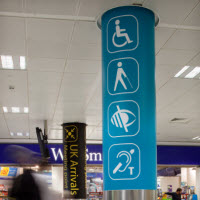Root Cause of Late Assistance at Airports Explained
- Written by Roberto Castiglioni
 Booking assistance at airports and being helped late is frustrating; a recently published report explains the root cause of delayed assistance and offers a solution to eliminating the problem.
Booking assistance at airports and being helped late is frustrating; a recently published report explains the root cause of delayed assistance and offers a solution to eliminating the problem.
There is nothing more frustrating than pre-booking assistance and having to wait longer than 30 minutes before being helped. Understandably, this is the number one category of passengers’ complaints.
In-depth data analysis helps understand what causes delays and if there are ways to eliminate them. A recently published report by PRM (Passengers with Reduced Mobility) Software provider OZION gives plenty of insight on the matter.
The report analyzed data from seven airports across Europe. One million requests for assistance were broken down into the journey details to identify what may trigger delays with assistance.
Before going into the reports’ findings it may be useful to review how assistance services work. Passengers request assistance at the time of booking their flights. The airline sends the information to the airport.
Assistance services schedule personnel based on the volume of requests for assistance to meet pre-set quality standards. This means that agents should be available within 10 minutes from the time the aircraft arrives on stand.
The key finding of the report is that 15.8% of passengers who requested assistance did not make themselves known to waiting staff. And that is the key problem. If staff is kept waiting for passengers who do not show up, they cannot proceed in time for their next assignment. The reports clearly explain the problem with the following example:
“An agent who is assigned to a passenger must travel to the arrivals gate from their location (the time for this varies depending on airport layout and dispatching policies, however, let us assume a 20-minute journey is realistic).
The agent must, according to the SLA arrive in a certain amount of time before the passenger’s arrival time. Upon no-show, it is hoped an agent will look for that passenger or wait for the aircraft to be fully emptied, let us allocate an additional 5 minutes.
In total, the agent has dedicated 35 minutes to a passenger who did not exist. During this time, another passenger elsewhere in the airport requiring assistance cannot be dealt with by this specific agent, adding pressure to the operation.”
The easy solution could be increasing staff numbers. However, this would not be financially sustainable. OZION offers the following solution: “Ozion PRM Manager’s Dynamic Reporting Module includes a No-Show Indicator tool. Management can run the required queries to identify the occurrence volumes and trends of no-shows.”
In a data-rich environment like the aviation industry, being in full control of data helps quickly identify the source of passengers’ no-show (by airline, route, or even time of day) and enables management to use data to interact with other stakeholders and find remedies and ways of mitigating, if not completely eradicating, the problem.
The No-Show Trend Analysis report is available for free on the OZION website.










